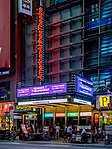229 West 43rd Street

229 West 43rd Street (formerly The New York Times Building, The New York Times Annex, and the Times Square Building) is an 18-story office building in the Theater District of Midtown Manhattan in New York City. Opened in 1913 and expanded in three stages, it was the headquarters of The New York Times newspaper until 2007. The original building by Mortimer J. Fox of Buchman & Fox, as well as a 1920s addition by Ludlow & Peabody and a 1930s addition by Albert Kahn, are on 43rd Street. Shreve, Lamb & Harmon designed a wing on 44th Street in the 1940s. Columbia Property Trust owns most of the structure as an office building while Kushner Companies owns the bottom four floors as a retail and entertainment complex. The 43rd Street sections of the building are designed in the French Gothic, French Renaissance, and Italian Renaissance styles and are a New York City designated landmark. The original building and its additions rise 11 stories from the street, except for a four-story wing on the eastern end of the site. The 43rd Street sections of the building are topped by a set back five-story attic, interrupted by a seven-story tower with a pyramidal hip roof. The facade is constructed of light-colored Indiana limestone, brick, and terracotta and is divided horizontally into a two-story base, a nine-story midsection, and the attic and tower stories. The elevations are divided into vertical bays with a mixture of single windows, double windows, and arches. The building contains 770,000 square feet (72,000 m2) of office space and 100,000 sq ft (9,300 m2) of retail space. Originally, each floor was devoted to a different division of the Times. Due to overcrowding at the previous Times headquarters at One Times Square, the Times Annex was constructed to supplement the paper's printing plant and other mechanical divisions. The annex became the Times's headquarters shortly after opening. As the Times's circulation expanded and its issues grew longer, the building was expanded in 1922–1924, 1931–1932, and 1944–1947. The Times relocated its printing plant from the building in 1997 and announced plans for new headquarters two years later, relocating in June 2007. A partnership led by Tishman Speyer bought the building in 2004 and sold it three years later to AFI USA, which had trouble finding office tenants and sold the upper floors to The Blackstone Group in 2011. AFI USA operated the retail portion of the building until 2015, when Columbia acquired the offices and Kushner bought the retail.
Excerpt from the Wikipedia article 229 West 43rd Street (License: CC BY-SA 3.0, Authors, Images).229 West 43rd Street
West 43rd Street, New York Manhattan
Geographical coordinates (GPS) Address External links Nearby Places Show on map
Geographical coordinates (GPS)
| Latitude | Longitude |
|---|---|
| N 40.7575 ° | E -73.987777777778 ° |
Address
Times Square Building
West 43rd Street 229
10036 New York, Manhattan
New York, United States
Open on Google Maps










